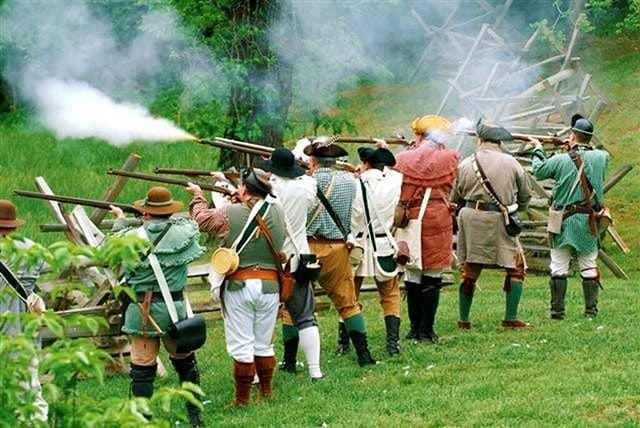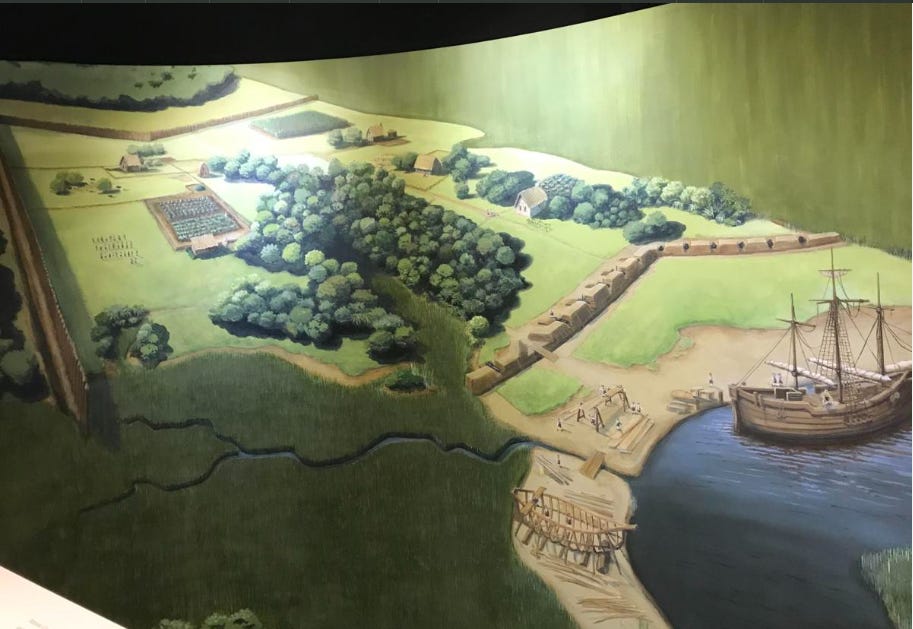#141: Day In The Life of Charles Towne's First Settlers (1670), Revolutionary War Encampment, and Fundraising for Taveau Church Restoration
For South Carolina history lovers far and wide! Published weekly on Monday mornings. Enjoy weekly SC history articles, upcoming SC historical events, and other South Carolina recommendations.
Dear readers,
Welcome to SC History Newsletter #141!
I hope the golf enthusiasts among you enjoyed the beautiful coverage of The Masters tournament this weekend. If you can believe it, my husband and his father were lucky enough to actually got to go IN PERSON to the tournament this year (on Thursday). It was a true bucket list item the gents will never forget. The loved every moment — from the gift shop to the concessions to walking the course. Their favorite food item was the Georgia Peace Ice Cream Sandwich. As we watched the finals from home last night, riffing on the Georgia peach theme, I made some peach cobbler for my husband and stepson. It was fun!
Meanwhile, we have a positive and important change to the newsletter, starting this week!
I have been reflecting on the newsletter for a few weeks now, and something seemed…missing.
I thought on this long and hard and I realized that I want this newsletter to be a vehicle for not just learning, but also, a vehicle for good!
I thought a lot about how we came together as a community and raised over $500 for Mount Vernon for my birthday this past January — which was amazing and I am so grateful! It was a wonderful feeling when the Mount Vernon development office confirmed they had received our collective donation.
With all this in mind, I have decided to pilot this new section of the newsletter, which I will call The Fundraising Corner, that will feature a monthly fundraising opportunity where we can come together as a group and make a difference for South Carolina history preservation and education in our state!
Once the fundraising goal has been met, I will coordinate the transfer of funds to the organization or cause as a donation “From the Subscribers of the South Carolina History Newsletter”!
For now, this section will replace the “Other SC Recommendations” section where we were recommending movies, products, etc. before.
Our SC History Newsletter fundraiser for the month of April is: “Restoring Taveau Church: Preserving Black History in SC”!
Our goal is to raise $200.
I am excited for you to read more about The Taveau Church restoration below and why I believe it is an important and worthy cause!
The funds will be raised through the 501c3 charity The Palmetto Trust for Historic Preservation in South Carolina (EIN: 57-0913191).
As before, we will use the platform GoFundMe.org to fundraise and if you choose to donate, you will receive a tax receipt from the PayPal Giving Fund via email.
I know this is a big change, but I hope you will embrace this new idea with me, and together, we can make a real difference :)
Additionally, in today’s history essay, we will dive into a “Day in the Life of Early Settlers in Charles Towne.”
Now, let’s learn some history!
Yours truly,
Kate
(Writing from Greenville, SC)
Support the SC History Newsletter by considering heritages teas (inspired by South Carolina and American history!) from our fantastic sponsor Oliver Pluff & Co. — click on their beautiful ad below! :)
➳ Housekeeping for new subscribers!
New friends! There are over 100 previous SC History newsletters on topics ranging from the founding of Charleston, sunken Confederate submarines, railroad tunnels filled with blue cheese, and more! See our archive here!
Send me your comments or topic ideas: I love it when subscribers write to me! Have a SC History topic or question you’d like for me to write about? Have additional ideas or feedback? Just reply to this email and let me know!
Join us on social: Keep the conversation going and join over 100 other subscribers by becoming a member of our SC History Newsletter Facebook Community here!
If your email “cuts off”: In your email app or website, if my emails “cut off” for you, please click the title of the email and it will take you to the full post on the Substack. I don’t want you to miss any content!
Love the SC History Newsletter? Please click the button below to share with a friend!
➳ Featured SC History Event of the Week:
🗓️ April 26-27, 10:00 am-4:00 pm
⛺ “Annual Revolutionary War Encampment”
📍Musgrove Mill State Historic Site | Clinton, SC
🎟️ $5/adult, $2/child 15yr and younger, $2.00 Children 15 and younger
💻 Website
From the event website:
“If you have ever been curious about how life was in South Carolina during the Revolutionary War or you are just looking for a fun way to spend a weekend then you need to come out to the Battle of Musgrove Mill State Historic Site on the weekend of April 26 and 27 for our Annual Living History Encampment! There will be reenactors portraying both Patriot and Loyalist militiamen, British Regular and Provincial soldiers, Continental soldiers, and civilians representing a variety of backgrounds. Throughout both days there will be several historic weapons demonstrations, historic lectures, militia musters for children, historic craft demonstrations, kid’s games, and sutlers selling goods to the public. You will also be able to interact directly with all of the reenactors throughout the weekend, so feel free to ask them any questions you might have about the Revolutionary War or about what you see. They will love to speak with you. The Encampment will be on both Saturday April 26 and Sunday April 27, 2025 from 10:00 am-4:00 pm. The price of admission will be $5.00 an adult and $2.00 for children age 15 and younger. Please bring bottled water, and prepare for the weather. If you have any questions, please contact the park at mgmillsp@scprt.com or (864) 938-0100.”
➳ 🗓️ Paid subscribers get access to my SC History Events Calendar that organizes all the upcoming SC history events I have discovered. Please let me know if you’d like to add an event to the calendar! Reply to this email to send me your events.
➳ NEW! Fundraising Corner
Restoring Taveau Church: Preserving Black History in SC
Here is information below about this important project on the Preservation SC website and why I believe this is a worthy cause for us to donate to:
"Taveau’s restoration, however, is about more than just preserving a historical structure because of its unique architecture. It would also be a testament to the faith of the Black men and women who preserved Taveau as a place for their worship and coincidentally, passed down 175 years of Black worship experience including inspired preaching and soulful spirituals. Taveau tells this important story as well as the story of the local area, its land, its people, and its culture."
—Reverend Clayton J. Jones, Sr.

History
“Martha Caroline Swinton Ball Taveau, wishing to worship as a Presbyterian amidst the Cooper River Episcopalians, built Taveau on Clermont Plantation in 1835.
Taveau, built during a tumultuous time, is an eyewitness to our nation’s history and an important site in the Gullah Geechee Cultural Heritage Corridor. The expertise of the early enslaved Africans created the infrastructure that allowed the cultivation of rice to occur along the southeast Atlantic coast, most profoundly in the SC Lowcountry. There is no available information that tells us what the enslaved were taught during Taveau’s “Presbyterian era” (1835-1847).
In 1847, upon the death of Mrs. Taveau, the church became the worship home for Black Methodists. Taveau was likely part of a Methodist Mission Circuit based in Charleston, a relationship that reflected the growth of Methodism in America in the 19th Century.
After the Civil War, and when a new Black Methodist Conference was organized, Taveau began a new page in its history. The unique strains of Gullah Geechee culture were reflected in the worship and development of community in this rural area. Taveau stood not only as a sentinel to the trials and accomplishments of its congregants but the activities within its walls helped shape the character of its people and community through Reconstruction, Jim Crow, and Civil Rights eras. By the early 1970’s Taveau’s congregation dwindled so it merged with a nearby congregation in Cordesville and the church ceased to be used.”
Architecture
“Taveau is a rare surviving rural, frame antebellum church. It is a plain building, the exterior marked by modest cornice and a simple Doric portico. The simplicity of the interior during its first decades of use fit an aesthetic that is both rural and evangelical.
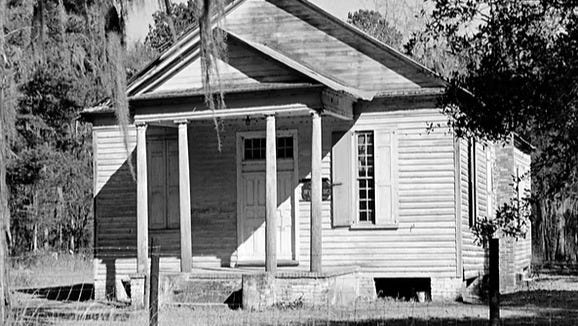
Materials were procured locally. Lumber, most likely sawn on site, provided the elements of the building’s structural components. Local timber was also sawn and planed into the twelve-light double row transoms set over the entrances, the sixteen light windows and their paneled shutters.
Building material incorporated in Taveau and the methods used in its construction express the skill of enslaved craftsmen.
Changes made to the interior of the church in the late nineteenth and twentieth centuries reflect the evolving character of worship expressed by the progeny of the church’s builders.”
Timeline
“In late June, 2023, and with the full support of the congregation, its ministers, and the Taveau Legacy Committee, we purchased historic Taveau from the United Methodist Conference.

Taveau is a remarkable survivor of a rural black church with rich history. For over 125 years Taveau was an active place of worship and gathering for Blacks.
This multi-year restoration project will return the historic church to usefulness as a local community space that is befitting of Taveau’s history and cultural legacy. We hope that you support this effort."
Please consider donating here, or via the button below. If only 20 of us chipped in $10 each, we will achieve our goal!
➳ SC History Topic of the Week:
A Day in the Life of Charles Towne’s First Settlers (1670)
Imagine it’s April 1670, and you are an eyewitness to the exact moment when roughly 150 of South Carolina’s first settlers arrive on their boat The Carolina at the west bank of the Ashley River, at a place now known as Charles Towne Landing.
The landing site, which they named Albemarle Point, was selected not only for its strategic location, but thanks to the guidance of the Kiawah Indians, who advised the settlers to avoid the Spanish-controlled Port Royal and instead settle further north in a place better suited for farming and safer from European rival.
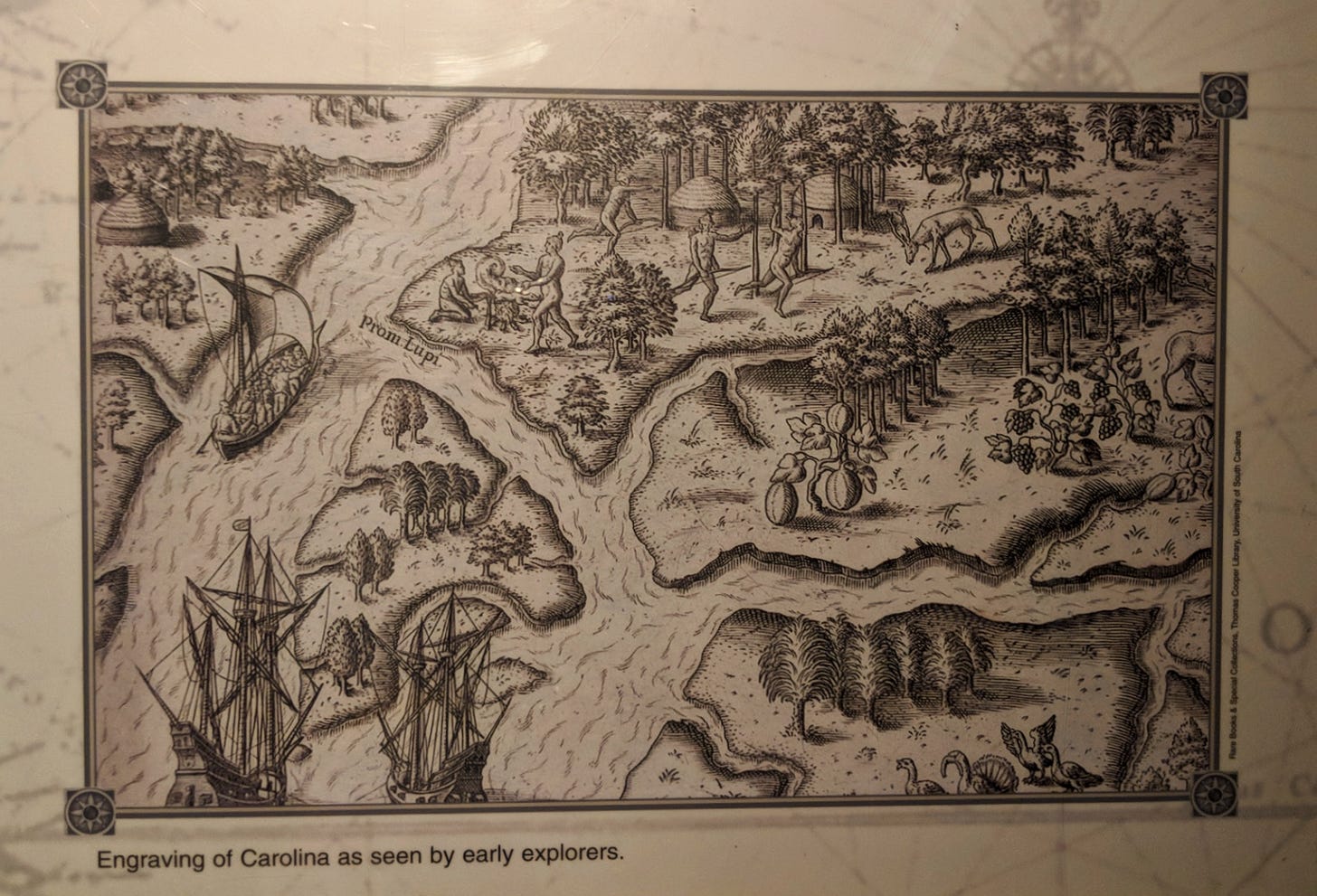
“This site on the Ashley River was easy for defense and provided for trade,” says Patrick Cook, Director of History and Education at Charles Towne Landing State Historic Site.
Note that Albermarle Point was named after George Monck, the Duke of Albermarle and one of the 8 Lords Proprietors who oversaw the region.
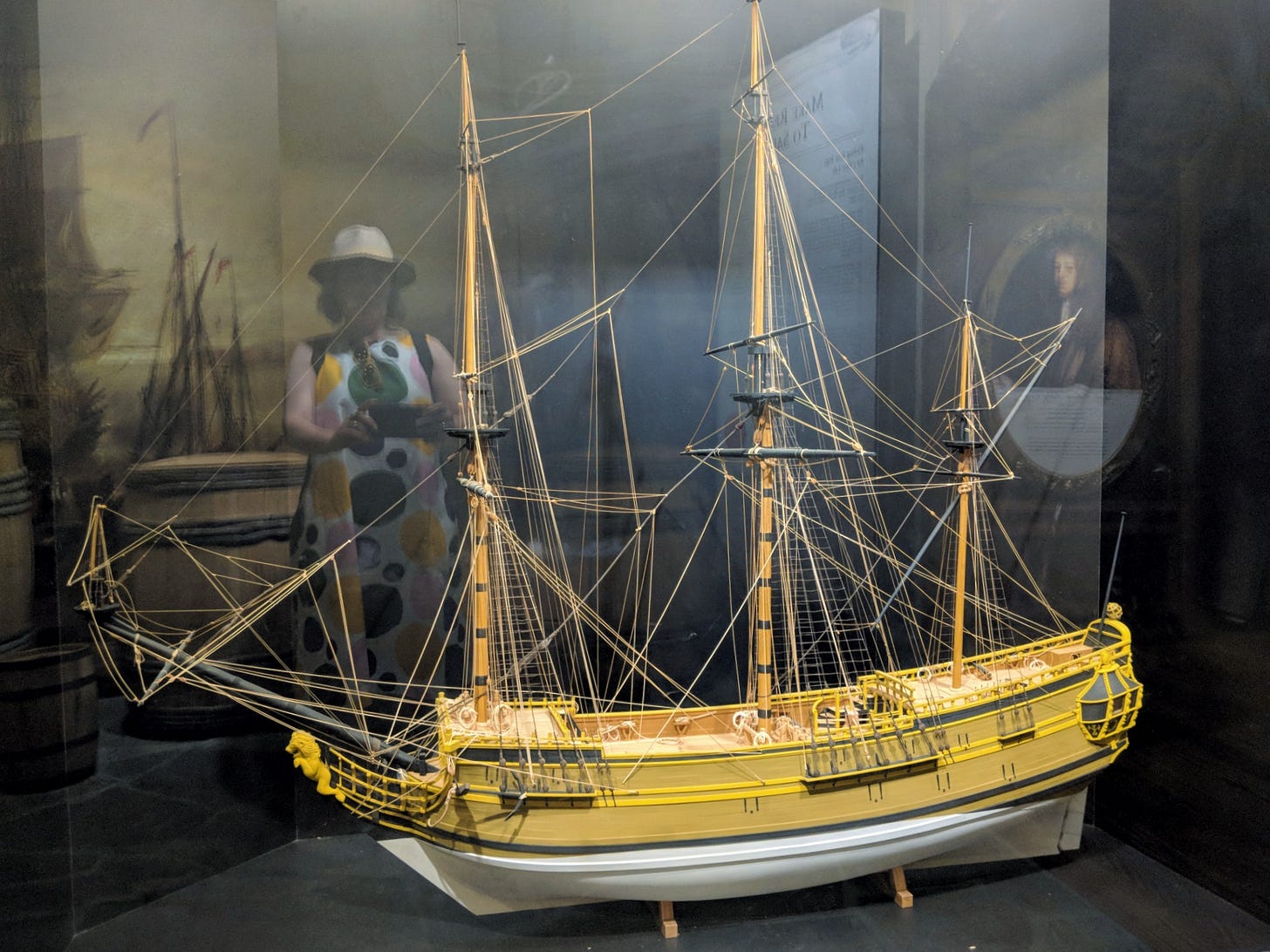
The settlers — men, women, children, and 3 enslaved Africans — disembark from the Carolina, a ship named in honor of King Charles II. You watch as their faces are full of wonder, curiosity, and likely a bit of hesitation and fear in this new, unknown land.
As they step off the vessel and push through marsh grasses and thick brush, the settlers encounter a landscape of towering hardwood trees and dense canopy so thick that it is hard for sunlight to penetrate through to the forest floor.
The settlers begin unloading essential supplies: “nails, hoes, shovels, bricks, clothing, candles, musket balls, and even a flag for the fortress.”
You watch as they work together on one of their first collective tasks to build a palisade for protection — a tall wooden wall of sharpened logs to protect against Spanish threats, wild animals, and rival tribes.
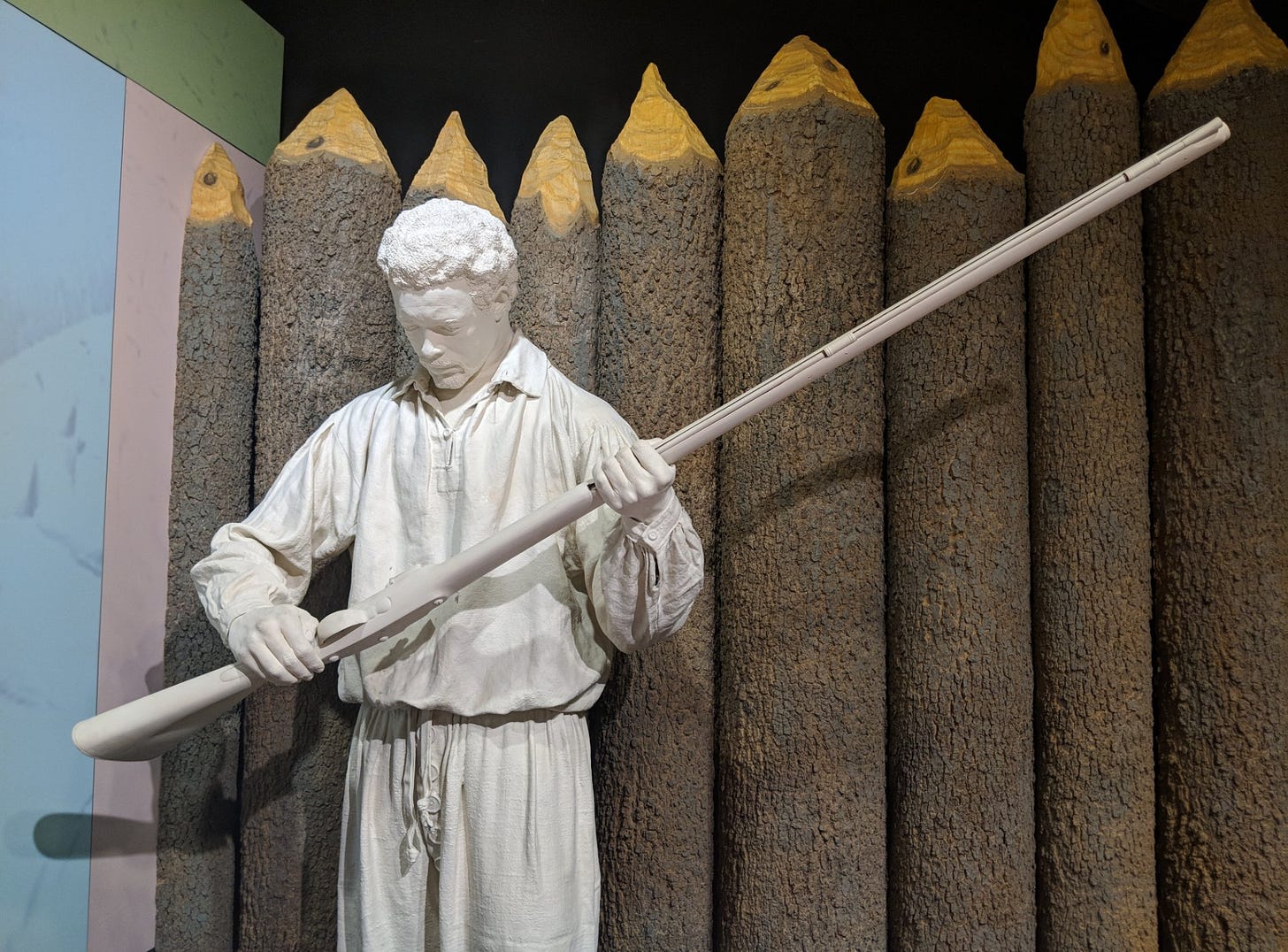
The group also works together to build watchtowers, dig protective trenches, and begin surveying land for homes, gardens, and pasture.
The settlement’s 9-acre parcel sat on a bluff surrounded by water on three sides —ideal for both defense and trade access.
The Lords Proprietors had learned from the failures of the settlement of Jamestown in Virginia, and the settlers at Charles Towne brought items to trade with the native peoples, such as “fishing nets, glass beads and scissors.”
For food, the settlers carried from the ship: “multiple bushels of peas, flour, oatmeal and salt, along with large quantities of beef, butter, cheese, oil and fish. And, of course, lots of beer and brandy made the voyage, as well.”
They also brought garden seeds to grow their own vegetables and tropical plants from Barbados in hopes of finding the “perfect money-making crop to make their venture prosperous and profitable.”
In the settlers’ agricultural supplies were cotton and indigo seeds, ginger roots, sugarcane, grapevines and olive cuttings.
Among the original settlers were at least 3 enslaved Africans, most likely brought from Barbados, where plantation slavery was already entrenched. These individuals played a crucial role from the beginning — clearing land, helping build dwellings, preparing fields, and performing domestic labor. I wish we could know their names, and who owned these individuals!
As the colony expanded, so did its dependence on enslaved labor. By the late 1670s and early 1680s, enslaved Africans were increasingly imported not only from the West Indies but directly from West Africa, where rice cultivation expertise would shape South Carolina’s future economy.
The colony’s first governor, William Sayle, was nearly 80 years old when he arrived with the settlers! Sir John Yeamans, a rival political figure, wrote of him, “a man of noe great sufficiency yet the ablest I could then meet with.” Despite his age, Sayle provided early leadership to the fledging colony.
Perhaps you see William Sayle (age 80) actively helping with the building of the protective palisade!
The settlers soon had contact with the Native tribes. There was a doctor among them, Dr. Henry Woodward, who was chosen by the settlers to befriend the local tribe, the Creek, and hopefully “turn them against” their Spanish rivals.
From Carolana.com:
“By 1685, Dr. Henry Woodward and the Creek had successfully eliminated all the Spanish missions along the coast and internally, including the Spanish mission at the confluence of the Flint River and the Chattahoochee River. From this point onward, the Creek were in constant contact with the English, first with traders who wanted goods for coastal whites, then settlers who wanted land. It was an association the Creek would come to regret.”
Henry Woodward also lived among Native Americans, learned their languages, and negotiated early alliances that helped the colony survive. His relationships with other tribes like the Cusabo, Kiawah, and Yamasee were essential in securing trade and peace in the colony’s earliest years.
You watch as the men of the settlement spend their days clearing trees, hunting game, building fences, and experimenting with crops.
Because the old-growth forests allowed little sunlight to the forest floor, settlers used a method called girdling—stripping bark around tree trunks to slowly kill them and allow light for crops to reach the forest floor.
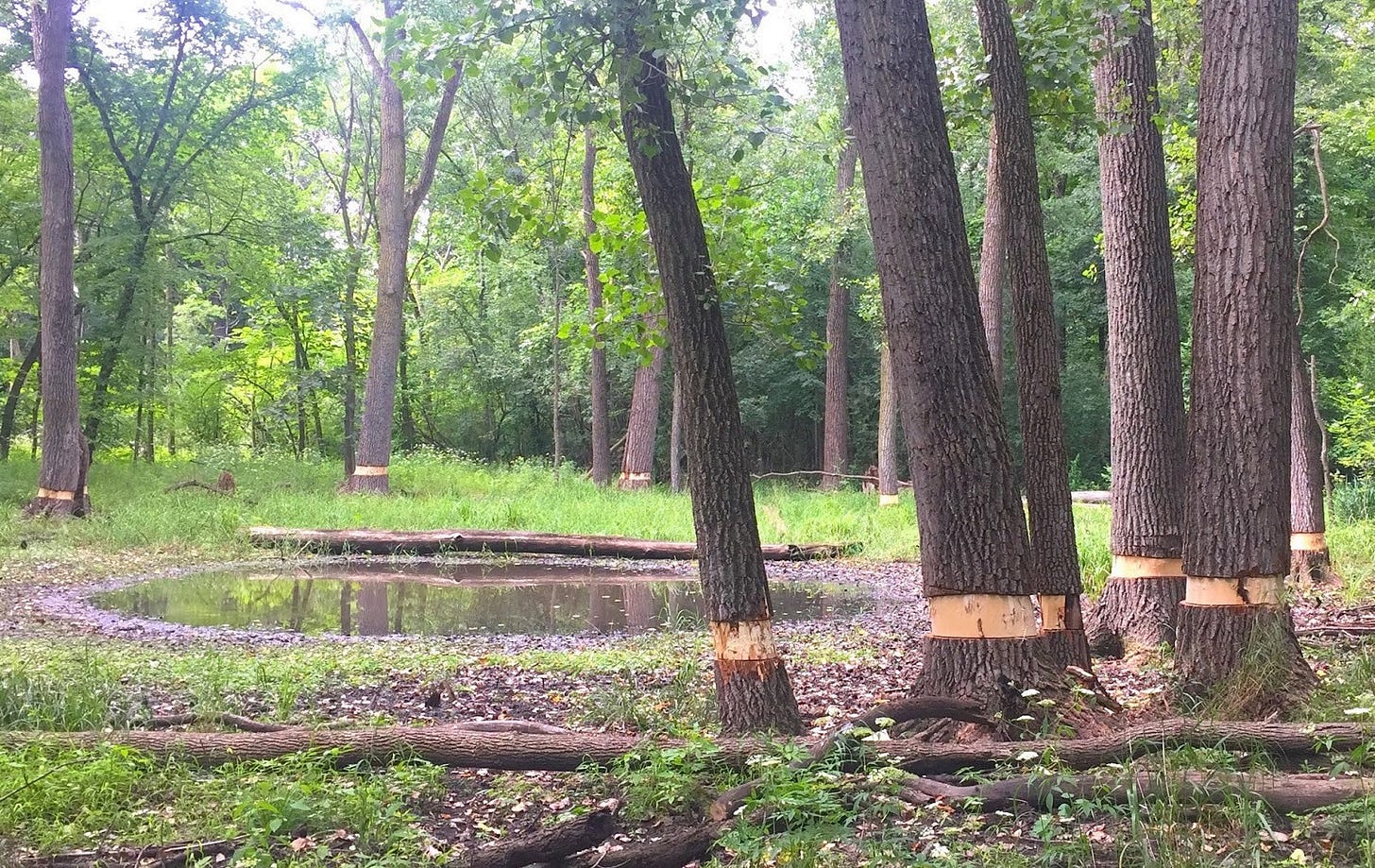
Hunting provided food like venison, wild turkey, and boar.
Women woke before dawn to tend fires, prepare meals, care for children, and maintain gardens. They spun thread, made candles and soap, and used herbs like rosemary and thyme for medicine and cooking.
Children gathered kindling, watered gardens, fed livestock, and learned skills by shadowing their parents. Life was harsh and deeply communal; every hand mattered.
Supplies from England were supplemented by foraged plants, game, and increasingly, garden vegetables. Meals might include corn mush, root vegetables, smoked fish, and stewed meats, with brandy and beer also in good supply.
You watch as the settlers’ evenings are marked by scripture reading, storytelling, and prayer. Most settlers were Anglican, but dissenters and Huguenots arrived soon after, giving early Charles Towne a spiritual diversity that shaped its culture.
We imagine visiting the home of Stephen Bull, an English settler and early land surveyor, as he pens a report to Lord Ashley back in England:
“We conceive this to be as healthfull a place as ever was settled. there is lande sufficient here for some thousands of People where they make very brave and happy settlements.”
Despite its promise, Albemarle Point had one major flaw: its low elevation and marshy surroundings created a haven for mosquitoes and sandflies. According to park historians, it was soon dubbed “no-see-um and mosquito hell.”
Within 10 years, most settlers relocated to Oyster Point, a breezier peninsula further downstream. There, trade boomed, homes expanded, and the Charleston we know today was born.
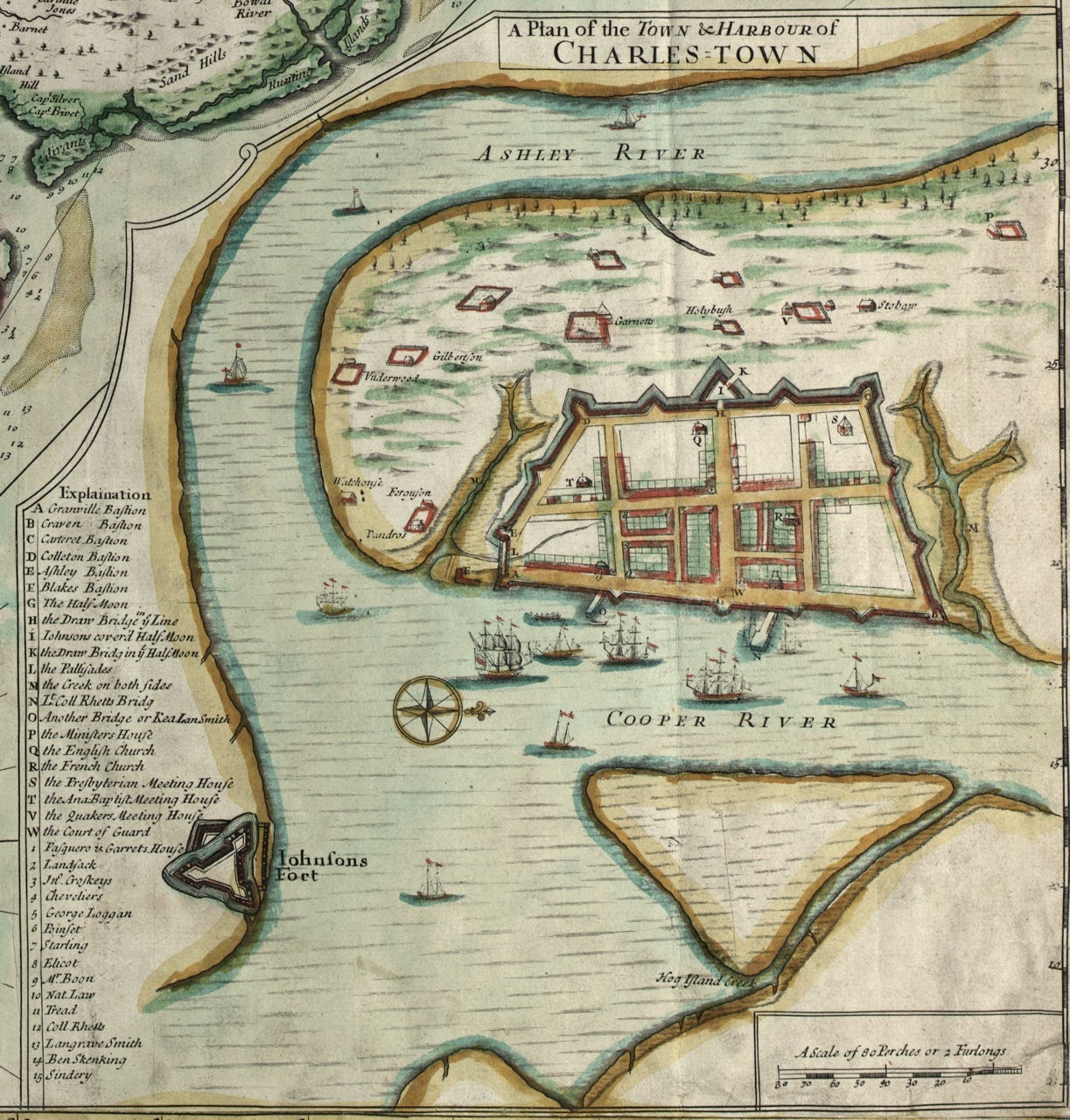
Have any of you been to the Charles Towne Landing State Historical Site? Tell us about your experience below!
If you voted just “OK” on the newsletter today, I want to hear from you! Reply to this email and send me your feedback. :)
➳ Sources — Day In The Life of an Early Charles Towne Colonial Settler
"350 Years Ago, Charleston’s First Settlers Carved a New Colony in a Pristine Wilderness." Post and Courier, https://www.postandcourier.com/news/350-years-ago-charlestons-first-settlers-carved-a-new-colony-in-a-pristine-wilderness/article_d2549dde-407b-11ea-8945-bfcdc2b6fe49.html. Accessed 14 Apr. 2025.
“Bull, William.” South Carolina Encyclopedia, https://www.scencyclopedia.org/sce/entries/bull-william/. Accessed 14 Apr. 2025.
“Charles Town’s Growing Pains.” Charleston Time Machine, Charleston County Public Library, https://www.ccpl.org/charleston-time-machine/charles-towns-growing-pains. Accessed 13 Apr. 2025.
“Earliest Fortifications at Oyster Point.” Charleston Time Machine, Charleston County Public Library, https://www.ccpl.org/charleston-time-machine/earliest-fortifications-oyster-point. Accessed 14 Apr. 2025.
“Charles Towne.” NCpedia, https://www.ncpedia.org/charles-towne. Accessed 13 Apr. 2025.
“Colonial Period of South Carolina.” Wikipedia, https://en.wikipedia.org/wiki/Colonial_period_of_South_Carolina. Accessed 13 Apr. 2025.
“Dr. Henry Woodward.” Carolana, https://www.carolana.com/Carolina/Explorers/henrywoodward.html#:~:text=By%201685%2C%20Dr.,between%20the%20Cherokees%20and%20Virginians. Accessed 14 Apr. 2025.
“Explorers and Settlers: Site E26—Charles Towne, South Carolina.” National Park Service, https://www.nps.gov/parkhistory/online_books/explorers/sitee26.htm. Accessed 13 Apr. 2025.
“National Register of Historic Places—Charleston: Charles Towne Landing.” South Carolina Department of Archives and History, http://www.nationalregister.sc.gov/charleston/S10817710011/pages/S1081771001101.htm. Accessed 14 Apr. 2025.
“The First Settlers: April 1670.” South Carolina Historical Society, https://schistory.org/april-1670/?utm_source=chatgpt.com. Accessed 13 Apr. 2025.










